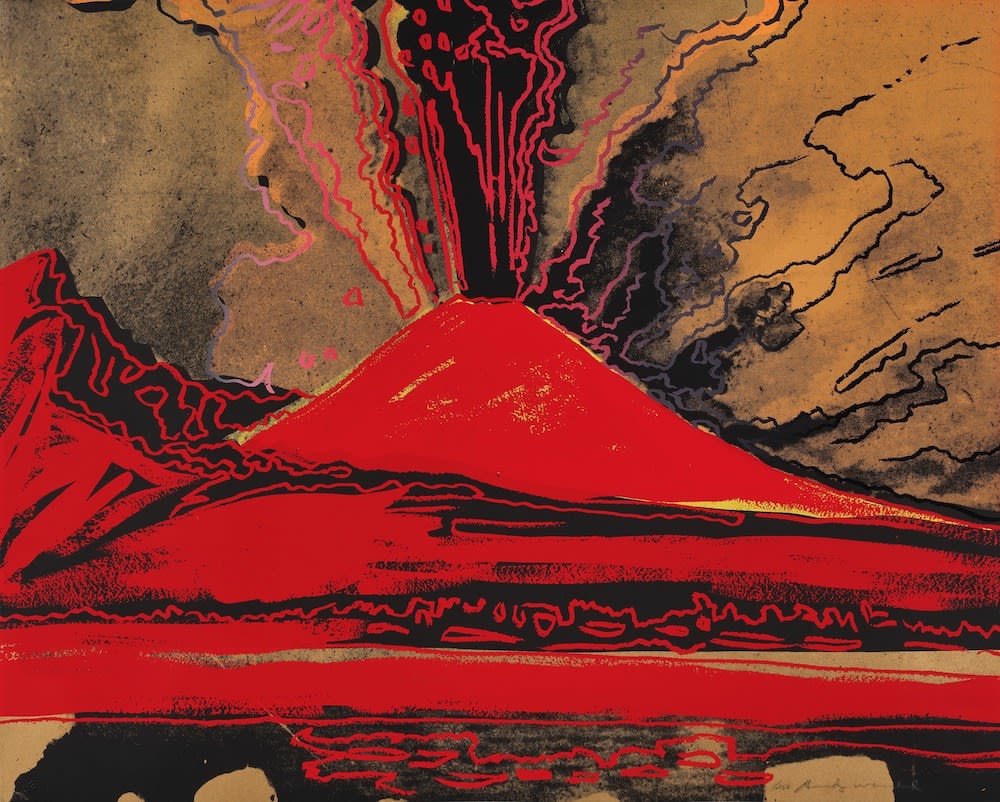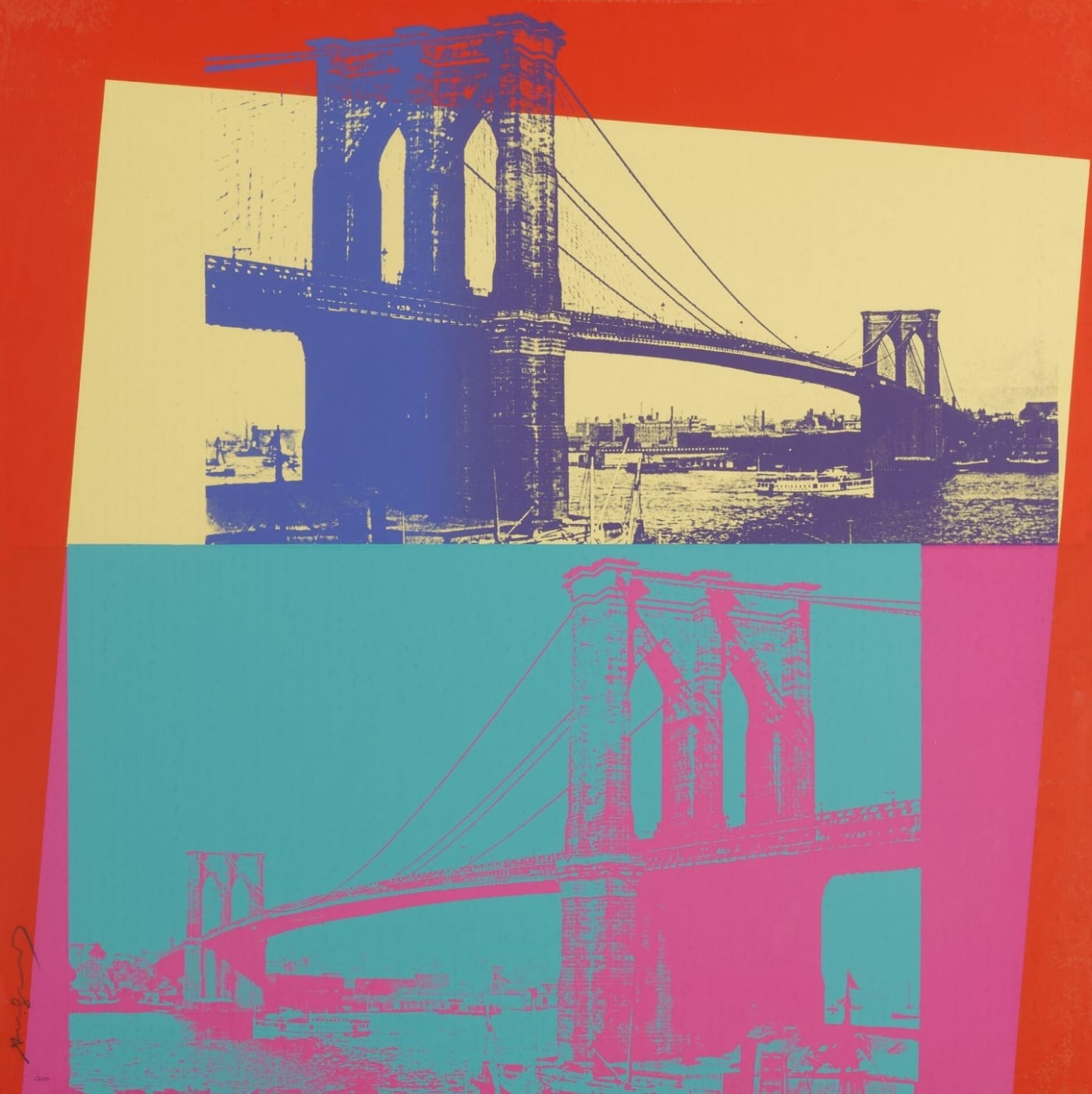
Pop art and Landscapes
Unlike Roy Lichtenstein prints, Warhol tended to shy away from subjects that were not directly linked to his interest in people, products and celebrity. Warhol’s published prints reveal an artist more interested in people than places. Of the 413 recorded published prints in the Feldman & Schellmann catalogue raisonne, only a handful relate to landscapes when compared to the themes and subject matter commonly associated with the artist.However, as with many things Warholian, looks can indeed be deceiving.
The Annunciation
Whilst not immediately recognised as a landscape artist, we can see the Warholian formula of image appropriation and reappropriation applied to his works that feature landscapes. Examining the Details of Renaissance Paintings we see Warhol’s gift for drawing from the pre-existing and creating something entirely new. Bombastic colours shatter the once peaceful scene as Warhol channels 400 years of Da Vinci into a hyper-kitch yet tasteful composition. Wathol behind a camera, voyeur, not revealed full details, given an innocuous snippet, playful the mountain of X in background. Elegant elevation, a twist in not choosing the more obvious reveals warhol’s skill throughout his career, to present the often overlooked as something special.

Vesuvius
Warhol turns to the quasi-mythical in his use of the mountain Vesuvius in the eponymous artwork released in 1985 Mount Vesuvius. Towering above the Gulf of Naples, has shaped history not only through its catastrophic eruptions but also as a symbol of nature’s uncontrollable might, standing in stark contrast to the frailty of human life. Warhol, better known for his portraits of celebrities and consumer icons, here turns his attention to the sublime power of nature, demonstrating his ability to convey landscapes with a deep emotional resonance.
In Warhol's Vesuvius the volcano is ablaze with intense red and black, colours that evoke the heat of molten lava and the choking darkness of ash-filled skies. Billowing smoke and jagged lines add to the sense of turmoil, capturing the raw energy of an eruption. Warhol's image isn't merely a landscape; it’s a portrayal of a looming, unpredictable force that has the power to destroy civilizations. The fear and awe provoked by Vesuvius' destructive potential resonate deeply with the artist, echoing the themes of death and disaster that pervade his earlier works, such as his depictions of electric chairs and car crashes.
For Warhol, Vesuvius was not just a natural spectacle; it represented the same inevitable doom that he explored throughout his career. In speaking of this particular series, Warhol noted, "I realised that everything I was doing must have been death." This connection between nature’s indifference and the fragility of human life is what gives his portrayal of Vesuvius its haunting power. The volcano stands as a monument to the forces that humankind cannot control, reminding us that despite our achievements, we remain vulnerable to the unpredictable and often devastating power of the natural world.

Brooklyn Bridge
From the organic power of nature to the power of man to shape our environment, the choice of subject matter—an architectural landmark—marks a significant departure from Warhol's typical focus. However, even in this unusual context, Warhol’s characteristic style is unmistakable, as he brings his unique perspective to the familiar symbol of the Brooklyn Bridge.
Warhol's lifelong love affair with New York City is evident in this work. By reversing the image of the bridge and stacking the mirrored images atop one another, he creates a collage-like quality that adds to the print’s personal and almost whimsical nature. This technique, which is aesthetically atypical for Warhol, brings out a surrealistic quality, transforming the bridge into something that appears to stretch endlessly, with no clear beginning or end. This sense of ambiguity and infinite repetition is a hallmark of Warhol’s approach, even when applied to an unexpected subject like the Brooklyn Bridge. Warhol elevates the Brooklyn Bridge into the realm of Pop Art. The work embodies an "excessively Warholian" image, where the ordinary becomes extraordinary through his lens.

Discover original Andy Warhol Art or contact Andipa Editions to buy Andy Warhol prints via sales@andipa.com or call +44 (0)20 7589 2371 for further information on any of the works featured.
